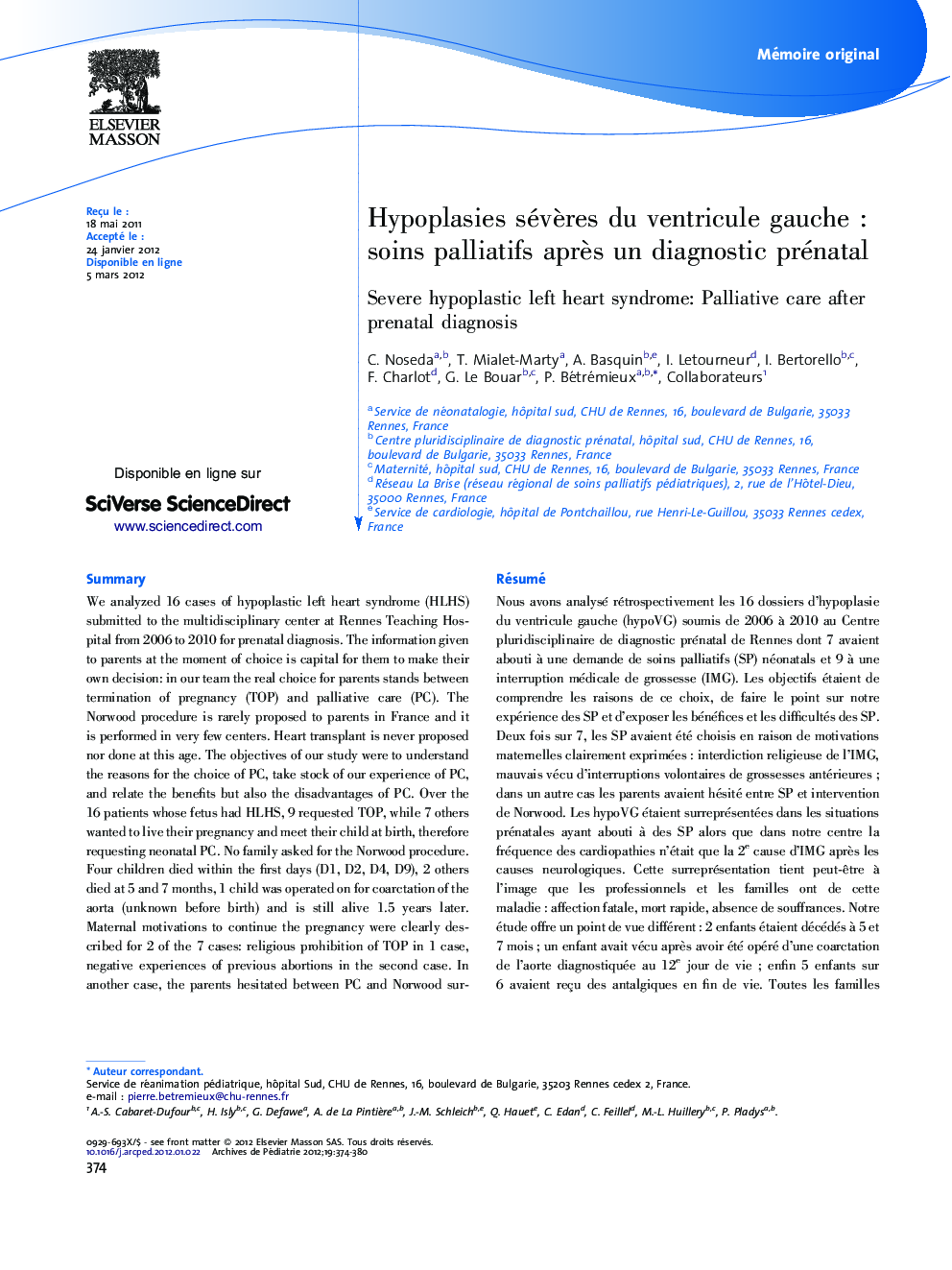| کد مقاله | کد نشریه | سال انتشار | مقاله انگلیسی | نسخه تمام متن |
|---|---|---|---|---|
| 4147351 | 1272671 | 2012 | 7 صفحه PDF | دانلود رایگان |

RésuméNous avons analysé rétrospectivement les 16 dossiers d’hypoplasie du ventricule gauche (hypoVG) soumis de 2006 à 2010 au Centre pluridisciplinaire de diagnostic prénatal de Rennes dont 7 avaient abouti à une demande de soins palliatifs (SP) néonatals et 9 à une interruption médicale de grossesse (IMG). Les objectifs étaient de comprendre les raisons de ce choix, de faire le point sur notre expérience des SP et d’exposer les bénéfices et les difficultés des SP. Deux fois sur 7, les SP avaient été choisis en raison de motivations maternelles clairement exprimées : interdiction religieuse de l’IMG, mauvais vécu d’interruptions volontaires de grossesses antérieures ; dans un autre cas les parents avaient hésité entre SP et intervention de Norwood. Les hypoVG étaient surreprésentées dans les situations prénatales ayant abouti à des SP alors que dans notre centre la fréquence des cardiopathies n’était que la 2e cause d’IMG après les causes neurologiques. Cette surreprésentation tient peut-être à l’image que les professionnels et les familles ont de cette maladie : affection fatale, mort rapide, absence de souffrances. Notre étude offre un point de vue différent : 2 enfants étaient décédés à 5 et 7 mois ; un enfant avait vécu après avoir été opéré d’une coarctation de l’aorte diagnostiquée au 12e jour de vie ; enfin 5 enfants sur 6 avaient reçu des antalgiques en fin de vie. Toutes les familles avaient été soutenues par le réseau de SP sauf une famille qui avait refusé. Les 6 autres avaient été satisfaites de leur choix malgré les difficultés rencontrées.
SummaryWe analyzed 16 cases of hypoplastic left heart syndrome (HLHS) submitted to the multidisciplinary center at Rennes Teaching Hospital from 2006 to 2010 for prenatal diagnosis. The information given to parents at the moment of choice is capital for them to make their own decision: in our team the real choice for parents stands between termination of pregnancy (TOP) and palliative care (PC). The Norwood procedure is rarely proposed to parents in France and it is performed in very few centers. Heart transplant is never proposed nor done at this age. The objectives of our study were to understand the reasons for the choice of PC, take stock of our experience of PC, and relate the benefits but also the disadvantages of PC. Over the 16 patients whose fetus had HLHS, 9 requested TOP, while 7 others wanted to live their pregnancy and meet their child at birth, therefore requesting neonatal PC. No family asked for the Norwood procedure. Four children died within the first days (D1, D2, D4, D9), 2 others died at 5 and 7 months, 1 child was operated on for coarctation of the aorta (unknown before birth) and is still alive 1.5 years later. Maternal motivations to continue the pregnancy were clearly described for 2 of the 7 cases: religious prohibition of TOP in 1 case, negative experiences of previous abortions in the second case. In another case, the parents hesitated between PC and Norwood surgery. For the other women, the reasons were less clearly expressed. In our series, HLHS is the first indication for PC from prenatal diagnosis (7/16 cases in the same period) while in the literature, heart diseases are the second cause of TOP after the neurological causes. The overrepresentation of this pathology in the families who opt for PC may be due to the unconscious image that both professionals and families have of HLHS: severity of an inevitably fatal disease, rapid postnatal death, and no suffering. Our study may change this view: a child was in fact carrying a curable defect which was discovered 12 days after birth, 2 children died at 5 and 7 months, and 5 of 6 children had major analgesics at the end of life. Nevertheless, the families were supported and followed by the PC network, except 1 who ruptured all contacts in a context of presumed intense suffering, but the other 6 do not regret their choice despite the difficulties.
Journal: Archives de Pédiatrie - Volume 19, Issue 4, April 2012, Pages 374–380